The global solid state LiDAR sensor market is estimated to grow from USD 1,971.8 million in 2025 to USD 10,759.0 million by 2035, representing an absolute increase of USD 8,787.2 million or 445.5% over the forecast period. The market is expected to expand at a compound annual growth rate (CAGR) of 18.5%, with the total market size increasing by nearly 5.5X between 2025 and 2035.
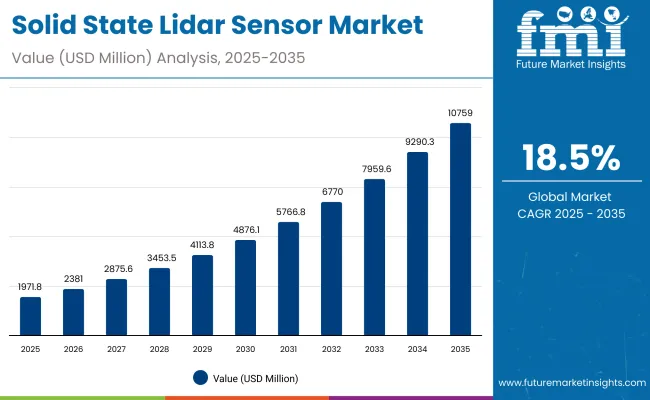
| Metric | Value |
|---|---|
| Industry Size (2025E) | USD 1,971.8 million |
| Industry Size (2035F) | USD 10,759.0 million |
| CAGR (2025 to 2035) | 18.5% |
Between 2025 and 2030, the market is projected to increase from USD 1,971.8 million to USD 4,876.1 million, contributing an incremental value of USD 2,904.3 million. Growth during this phase will be largely driven by the accelerated deployment of advanced driver-assistance systems (ADAS) and autonomous driving features in premium passenger cars. Key OEMs are integrating solid state LiDAR sensors into forward-facing and surround-view systems, aiming to improve safety, lane keeping, and adaptive cruise control. Parallel expansion in autonomous last-mile delivery bots, shuttle vehicles, and mining trucks is also expected to support volume ramp-ups.
From 2030 to 2035, the market is set to rise from USD 4,876.1 million to USD 10,759.0 million, contributing an additional USD 5,882.9 million in value. This second phase of growth will be led by the integration of LiDAR into cost-sensitive mid-range vehicles, smart city infrastructure, robotics, and logistics automation. Mass-market electrification, 3D mapping for urban planning, and indoor/outdoor warehouse automation will support broader adoption. Cost declines from MEMS and optical phased array technologies will enable more compact, low-power, and ruggedized LiDAR platforms to enter mainstream applications across multiple sectors.
Between 2020 and 2025, the global solid state LiDAR sensor market expanded from USD 935.2 million to USD 1,971.8 million, marking a total increase of USD 1,036.6 million or 110.9%, at a compound annual growth rate (CAGR) of 16.0%. This rapid early-stage expansion was fueled by escalating demand for reliable and cost-efficient LiDAR technologies that could meet the durability and scalability requirements of automotive, robotics, and industrial automation environments.
A significant shift occurred during this period as manufacturers transitioned from bulky, mechanical LiDARs to chip-based and MEMS-enabled solid state formats. These systems offered enhanced resilience, lower production costs, and the ability to be integrated into the body structure of vehicles and robots without moving parts. Automakers such as Volvo, Mercedes-Benz, and Honda initiated pilot integrations of solid state LiDAR units for limited-level autonomous driving features, especially in highway scenarios.
Technological milestones included the commercial availability of solid state LiDARs based on flash and optical phased array (OPA) architectures, offering increased resolution and a wider field of view. Players like Innoviz Technologies, Aeva, and Luminar introduced units with improved point density, detection range, and multi-object tracking capabilities. Meanwhile, chipmakers and sensor integrators began developing edge-processing-enabled LiDAR modules for real-time 3D perception tasks.
Regulatory bodies in the USA, Europe, and East Asia began supporting the use of LiDAR in new vehicle safety standards and traffic automation guidelines, giving a strong signal to OEMs and Tier 1 suppliers to accelerate R&D investments. Non-automotive applications such as security surveillance, warehouse automation, and smart agriculture also began to adopt compact LiDAR sensors for cost-sensitive use cases.
By the end of 2025, the solid state LiDAR sensor market positioned itself as a foundational sensor technology across both advanced mobility systems and intelligent infrastructure, establishing a robust platform for accelerated deployment in the coming decade.
The global solid state LiDAR sensor market is growing at a strong pace due to its increasing deployment in safety-critical systems, autonomous mobility, and next-generation industrial automation. Unlike mechanical LiDARs, solid state variants offer greater durability, cost efficiency, and integration flexibility, which make them suitable for high-volume applications. The push for full autonomy in passenger vehicles, robotaxis, and commercial fleets has placed solid state LiDAR at the center of perception system strategies.
Demand is also expanding in non-automotive sectors, where smart infrastructure projects, robotic platforms, and warehouse automation systems are adopting solid state LiDAR to enable 3D sensing, obstacle detection, and high-accuracy mapping. These use cases are driving volume-based manufacturing and price rationalization, encouraging adoption across medium- and low-tier applications. The growth trajectory is further reinforced by VC investments, strategic OEM partnerships, and regulatory incentives.
High-resolution scanning, lower latency, edge-processing capabilities, and increasing compatibility with AI-based platforms are also enabling solid state LiDAR to move beyond niche markets. Tier 1 suppliers are consolidating their sensor portfolios around scalable, solid state architectures that are compact, power-efficient, and optimized for software-defined vehicles.
The market is segmented by type into MEMS LiDAR, Flash LiDAR, Optical Phased Array LiDAR, and Scanning/Phased Array LiDAR. Each type offers distinct advantages in terms of beam steering method, cost, and integration feasibility, making them suitable for varied autonomy levels and robotic functions. Range capabilities are classified into short, medium, and long range, each catering to specific applications such as indoor navigation, highway autopilot, or large-scale mapping.
Application-wise, the market spans autonomous vehicles and ADAS, robotics, drones and UAVs, industrial automation, and various infrastructure and environmental monitoring tasks. At the component level, the value chain comprises laser sources, receivers, optics, and processing units, which together enable precision scanning, real-time perception, and advanced decision-making.

MEMS-based solid state LiDAR systems are expected to command 35% of the global market share in 2025. Their compact architecture, low power consumption, and cost-efficient design make them ideal for integration into autonomous vehicles and driver assistance systems. MEMS LiDAR enables beam steering without mechanical components, improving reliability and reducing maintenance.
OEMs prefer MEMS variants due to their scalability for Level 2 to Level 4 autonomy in passenger and commercial vehicles. The increasing rollout of electric robotaxis and shuttles has further supported adoption, particularly across China, Japan, and parts of the USA Additionally, suppliers are enhancing MEMS packaging with robust thermal management, enabling outdoor deployment in drones and robotics.
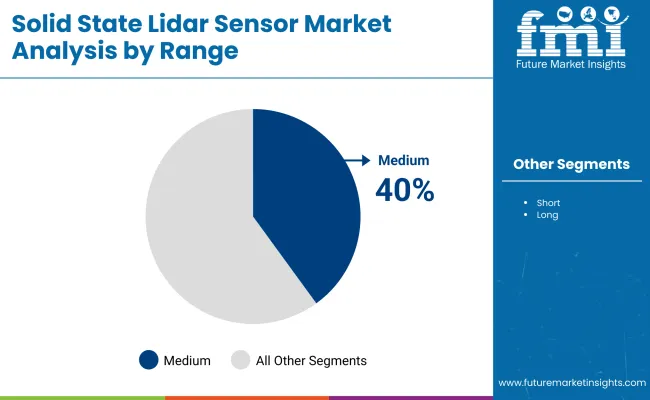
Medium-range solid state LiDAR systems are projected to hold a 40% share of the total market in 2025, emerging as the preferred option for highway and urban driving assistance. These sensors typically operate within 20 to 100 meters, balancing detection distance with high-resolution object tracking. OEMs have increasingly integrated medium-range sensors in blind spot detection, lane change assistance, and collision warning modules.
Their use is also expanding in last-mile autonomous delivery bots and warehouse robots requiring navigation in confined zones. The continued advancement in ASIC integration and real-time signal processing is improving frame rates and resolution at medium range, contributing to faster object classification. Medium-range sensors are now being co-located with radar and vision sensors for enhanced 360-degree awareness in ADAS platforms.
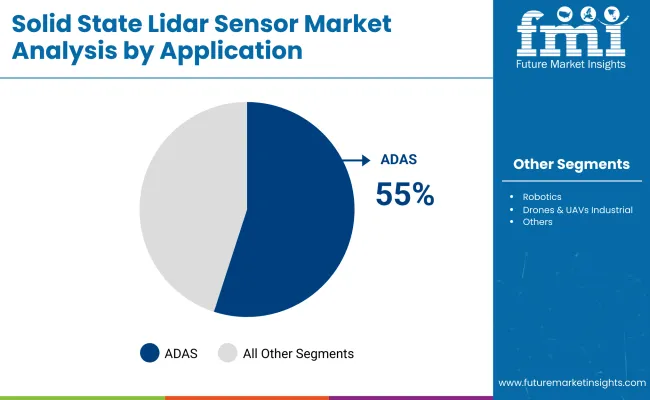
The autonomous vehicle and ADAS segment is expected to contribute 55% to the global demand for solid state LiDAR sensors in 2025. This segment is witnessing widespread adoption of LiDAR as a critical redundancy sensor for camera and radar-based systems. OEMs are increasingly deploying LiDAR across Level 2+ and Level 3 platforms, particularly in highway pilot and self-parking modules.
Expansion of sensor suites in premium models and rising regulatory pressure for active safety systems are accelerating demand. Automakers like Volvo, Honda, and Hyundai have committed to integrating LiDAR as a standard component in upcoming autonomous-ready models. Additionally, collaborations between LiDAR manufacturers and automotive chipmakers are enhancing sensor-fusion capabilities for real-time environmental modeling.
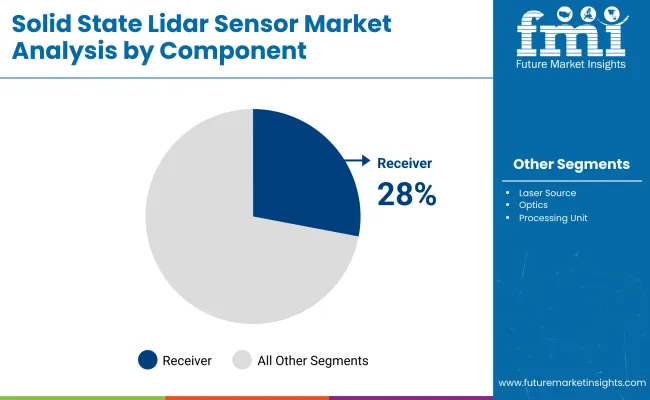
Laser sources and processing units are projected to collectively represent 28% of component-level demand in 2025, each holding approximately 25%. The laser source is central to the LiDAR’s performance, determining beam wavelength, divergence, and eye safety. Suppliers are innovating with eye-safe 905nm and 1550nm lasers to enable longer range without compromising user safety.
On the other hand, processing units have emerged as key differentiators, supporting advanced algorithms for object detection, segmentation, and classification. Edge AI capabilities are increasingly integrated within LiDAR systems to enable real-time processing directly on the sensor. Partnerships with chipmakers like NVIDIA and Qualcomm are helping LiDAR vendors embed greater processing power into smaller footprints, essential for automotive and drone applications.
The global solid state LiDAR market is being driven by a combination of performance improvements, production scalability, and integration readiness across mobility, industrial, and infrastructure domains. Solid state architectures eliminate moving parts, resulting in higher mechanical reliability and extended service life. This attribute makes them highly suitable for autonomous vehicles, drones, and robotic systems where consistent environmental sensing is crucial.
Automotive Integration Shifts Toward Cost-Efficient LiDARs
OEMs are actively moving toward affordable LiDAR integration across Level 2+ and Level 3 autonomous platforms. Solid state variants are increasingly chosen over mechanical alternatives due to their compact design, lower BOM (bill of materials), and ease of embedded positioning in bumpers, headlamps, and rooftop modules. Automakers in Europe, China, and North America are partnering with LiDAR suppliers for tailored modules aligned with ADAS and highway pilot requirements.
Industrial and Infrastructure Adoption on the Rise
Warehousing, smart cities, and industrial automation sectors are deploying solid state LiDARs for tasks including asset localization, perimeter detection, and traffic flow optimization. Fixed-mount LiDARs with wide field-of-view (FoV) and edge AI processing capabilities are being incorporated into smart intersections, ports, and railway safety systems, broadening the market beyond automotive.
M&A and Strategic Investments Accelerating Commercialization
Industry consolidation is reshaping the supplier ecosystem. Key LiDAR firms are entering into mergers or forming partnerships with Tier 1 automotive suppliers, chipmakers, or contract manufacturers to scale operations and reduce per-unit costs. For instance, LiDAR startups with proprietary ASICs or proprietary beam-steering tech are being acquired to secure patent portfolios and accelerate time to market.
Software-Defined Perception Systems Enhancing Value Proposition
Increasing reliance on software-defined sensors is making LiDAR units smarter, more adaptable, and upgradable over time. Solid state LiDARs now come bundled with perception algorithms, enabling features like object classification, lane modeling, and 3D semantic segmentation. These functionalities increase the utility of LiDAR data in real-time decision-making across mobility and robotics.
The Europe solid state LiDAR market is projected to expand from USD 488.1 million in 2025 to USD 2,160.4 million by 2035, growing at a CAGR of 16.0%. Germany, France, and the UK are poised to lead regional adoption, driven by strong automotive manufacturing bases and early-stage ADAS regulation enforcement.
Germany is expected to increase its share from 22.0% in 2025 to 25.2% by 2035 due to its leadership in autonomous mobility and partnerships between OEMs and LiDAR startups. France and the UK are projected to maintain consistent shares, supported by logistics automation and smart infrastructure initiatives. BENELUX countries are witnessing fast adoption in port logistics and smart city pilot deployments, while Rest of Europe is expected to contribute a quarter of the regional demand by 2035 due to broader integration into industrial automation and rail safety applications.
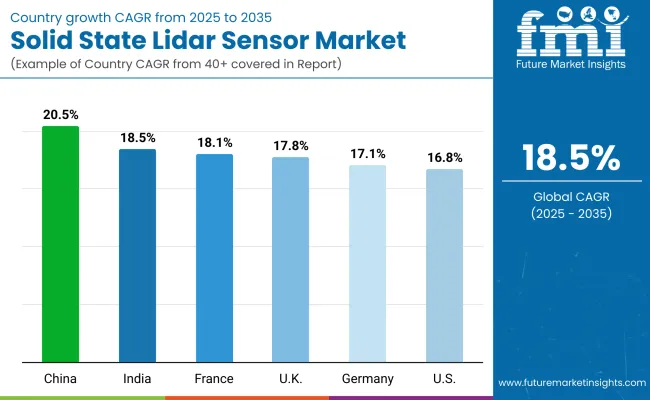
China is forecast to record the highest CAGR of 20.5% during the 2025 to 2035 period, driven by large-scale deployment in autonomous mobility pilots, smart city initiatives, and industrial robotics. A rising number of government-backed projects, together with cost declines in domestic lidar manufacturing, is accelerating adoption. Partnerships between lidar suppliers and domestic EV brands are further reinforcing the country’s position as a volume leader.
India is expected to grow at a CAGR of 18.5% over the forecast period, benefitting from its expanding electric vehicle ecosystem and progressive safety regulations. Government incentives under FAME-II, along with domestic electronics manufacturing schemes, are supporting lidar integration in passenger vehicles, metro infrastructure, and UAV navigation platforms.
France is projected to witness a CAGR of 18.1% between 2025 and 2035, led by demand from automotive OEMs and public transport authorities. Increasing investment in autonomous trams and metro systems, alongside retrofitting in logistics hubs and airports, is supporting sustained demand. The market is further bolstered by favorable data privacy and safety compliance frameworks.
The United Kingdom is projected to grow at a CAGR of 17.8%, with key growth stemming from smart city integration, drone-based surveying, and defense applications. The UK’s focus on resilient infrastructure and vehicle safety technologies is increasing procurement of solid state lidar systems by public agencies and OEMs alike.
Germany is expected to grow at a CAGR of 17.1%, with premium automotive manufacturers integrating solid state lidar sensors in upcoming EV models. OEM collaborations with sensor tech firms are targeting long-range, high-precision lidar for highway autonomy and advanced ADAS. Industrial robotics and factory safety also offer additional growth levers.
The United States is projected to register a CAGR of 16.8%, with strong interest in solid state lidar for security surveillance, warehouse automation, and autonomous fleets. While AV testing slowed temporarily, lidar demand has pivoted to logistics, port monitoring, and facility perimeter detection systems. Partnerships with federal agencies continue to shape long-term demand.
Japan’s solid state lidar market is led by medium-range sensors, which are estimated to hold a 47% share in 2025. These sensors are increasingly favored in urban mobility applications, including autonomous shuttles, robo-taxis, and ADAS for passenger vehicles operating in high-traffic city environments. Short-range lidar, with a 28% share, is primarily utilized in robotic arms, forklifts, and manufacturing floor automation, while long-range lidar (25%) is gradually being integrated into next-generation highway-driving systems in Japanese EV platforms.
In South Korea, MEMS (Micro-Electro-Mechanical Systems) LiDAR is projected to dominate with a 38% share in 2025, driven by its compact form factor and high manufacturability. These systems are favored in electric vehicles and consumer-grade robots. Flash LiDAR follows with a 26% share, supported by demand in mobile robotics and automated indoor navigation. Optical Phased Array (OPA) LiDAR, holding 20%, is gaining ground in precision applications, especially in surveillance and AR systems. Scanning/Phased Array LiDAR, accounting for 16%, is witnessing limited but specialized deployment in automotive R&D and defense-grade mapping systems.
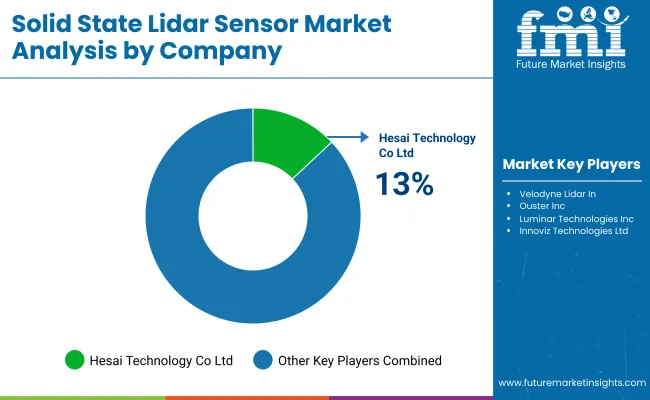
Competition in the solid-state LiDAR market is being driven by rapid technological advancements and strategic product launches. Companies are introducing sensors with MEMS-based mirrors, Time-of-Flight integration, and advanced beam-steering technologies to enhance detection accuracy, reliability, and range for ADAS, autonomous vehicles, industrial automation, and robotics.
The market is witnessing intensified rivalry as firms focus on compact, high-precision designs, in-house software stacks, and proprietary chip integration to differentiate offerings. Simultaneously, early commercialization of automotive- and consumer-grade systems is accelerating adoption, while investments in sensor miniaturization, cost reduction, and interoperability are shaping the competitive landscape across global LiDAR applications.
| Item | Value |
|---|---|
| Quantitative Units | Volume (Units), Value (USD Million), CAGR (%), Y-o-Y Growth (%) |
| By Type | MEMS LiDAR, Flash LiDAR, Optical Phased Array LiDAR, Scanning/Phased Array LiDAR |
| By Range | Short Range, Medium Range, Long Range |
| By Application | Automotive, Robotics & Automation, Consumer Electronics, Industrial Equipment, Mapping & Surveying, Others |
| Market Participants | OEMs, Tier 1 Suppliers, Technology Integrators, Research Institutes |
| By Region | North America, Latin America, Eastern Europe, Western Europe, East Asia, South Asia & Pacific, Middle East & Africa |
| Countries Covered | USA, Canada, Mexico, Brazil, Germany, UK, France, Italy, Spain, BENELUX, Russia, Poland, Hungary, China, Japan, South Korea, India, Türkiye , GCC, South Africa |
The global market is projected to reach USD 10,759.0 million by 2035, growing at a CAGR of 18.5% from 2025 to 2035.
East Asia, led by China and Japan, is expected to register the highest absolute value growth due to aggressive EV deployment and L3-L5 autonomy integration.
MEMS-based LiDAR is most popular in automotive use cases due to its compact size, durability, and ability to handle high-speed object detection.
Key non-automotive applications include industrial robotics, mobile mapping systems, drones, and augmented reality (AR) devices.
Demand is rising due to their optimal balance of range, resolution, and cost, making them suitable for autonomous shuttles, robotic forklifts, and smart infrastructure systems.






Our Research Products

The "Full Research Suite" delivers actionable market intel, deep dives on markets or technologies, so clients act faster, cut risk, and unlock growth.

The Leaderboard benchmarks and ranks top vendors, classifying them as Established Leaders, Leading Challengers, or Disruptors & Challengers.

Locates where complements amplify value and substitutes erode it, forecasting net impact by horizon

We deliver granular, decision-grade intel: market sizing, 5-year forecasts, pricing, adoption, usage, revenue, and operational KPIs—plus competitor tracking, regulation, and value chains—across 60 countries broadly.

Spot the shifts before they hit your P&L. We track inflection points, adoption curves, pricing moves, and ecosystem plays to show where demand is heading, why it is changing, and what to do next across high-growth markets and disruptive tech

Real-time reads of user behavior. We track shifting priorities, perceptions of today’s and next-gen services, and provider experience, then pace how fast tech moves from trial to adoption, blending buyer, consumer, and channel inputs with social signals (#WhySwitch, #UX).

Partner with our analyst team to build a custom report designed around your business priorities. From analysing market trends to assessing competitors or crafting bespoke datasets, we tailor insights to your needs.
Supplier Intelligence
Discovery & Profiling
Capacity & Footprint
Performance & Risk
Compliance & Governance
Commercial Readiness
Who Supplies Whom
Scorecards & Shortlists
Playbooks & Docs
Category Intelligence
Definition & Scope
Demand & Use Cases
Cost Drivers
Market Structure
Supply Chain Map
Trade & Policy
Operating Norms
Deliverables
Buyer Intelligence
Account Basics
Spend & Scope
Procurement Model
Vendor Requirements
Terms & Policies
Entry Strategy
Pain Points & Triggers
Outputs
Pricing Analysis
Benchmarks
Trends
Should-Cost
Indexation
Landed Cost
Commercial Terms
Deliverables
Brand Analysis
Positioning & Value Prop
Share & Presence
Customer Evidence
Go-to-Market
Digital & Reputation
Compliance & Trust
KPIs & Gaps
Outputs
Full Research Suite comprises of:
Market outlook & trends analysis
Interviews & case studies
Strategic recommendations
Vendor profiles & capabilities analysis
5-year forecasts
8 regions and 60+ country-level data splits
Market segment data splits
12 months of continuous data updates
DELIVERED AS:
PDF EXCEL ONLINE
Solid-State Microwave Source Market Size and Share Forecast Outlook 2025 to 2035
Solid State Relay Market Size and Share Forecast Outlook 2025 to 2035
Solid State Battery Silicon Carbon Negative Electrode Market Size and Share Forecast Outlook 2025 to 2035
Solid-State Array Market Size and Share Forecast Outlook 2025 to 2035
Solid-State Power Amplifier Market Size and Share Forecast Outlook 2025 to 2035
Solid-State Lighting Market Size and Share Forecast Outlook 2025 to 2035
Solid State Drive Market Size and Share Forecast Outlook 2025 to 2035
Solid State Power Controller Market Size and Share Forecast Outlook 2025 to 2035
Solid State Lighting System Market Size and Share Forecast Outlook 2025 to 2035
Solid State Lasers Market Analysis - Growth & Forecast 2025 to 2035
Solid-State Cooling Market Analysis & Forecast by Type, Product, End-user Industry, and Region Through 2035
5G Solid State Switches Market Size and Share Forecast Outlook 2025 to 2035
Asia Pacific Solid State Transformers Market Size and Share Forecast Outlook 2025 to 2035
Lithium-sulfur Solid-state Batteries Market Size and Share Forecast Outlook 2025 to 2035
Cathode Materials for Solid State Battery Market Size and Share Forecast Outlook 2025 to 2035
LiDAR Pulsed Fiber Laser Market Size and Share Forecast Outlook 2025 to 2035
Solid Aluminium Cladding Panel Market Size and Share Forecast Outlook 2025 to 2035
Sensor Data Analytics Market Size and Share Forecast Outlook 2025 to 2035
Solid White Films Market Size and Share Forecast Outlook 2025 to 2035
Sensor Testing Market Forecast Outlook 2025 to 2035

Thank you!
You will receive an email from our Business Development Manager. Please be sure to check your SPAM/JUNK folder too.
Chat With
MaRIA